The highlight of our trip to Cambodia was no doubt the day we spent exploring Angkor Wat and its surrounding temples in the outskirts of Siem Reap on two wheels.
While most visitors to Angkor Wat usually choose to hire a tuk-tuk or a driver to bring them around the temples at a leisurely pace, I had received a recommendation from Prince of Travel reader Dave to embark on a cycle tour instead if I wanted to explore the area in a much more active fashion.
Jessy and I were down for a little bit of adventure, so we booked the full-day cycle tour with Camouflage Adventure Cambodia for US$42 each.
The tour ticket comes with the mountain bike, helmet, lunch, water, snacks, tuk-tuk transfers to the hotel, and an English-speaking tour guide all included, and I thought it was an excellent deal for a seven-hour private guided tour.
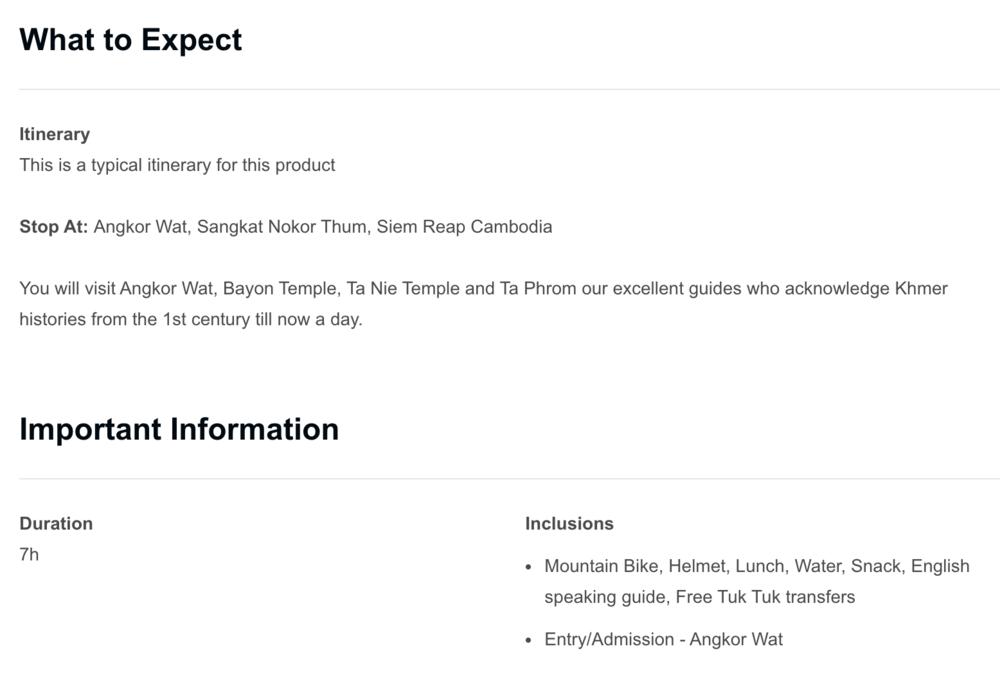
It’s worth noting that the TripAdvisor page also states that admission tickets to Angkor Wat are included as well, which was not the case – indeed, shortly after booking the tour, I received a “very apologetic” message from the tour operator as follows:
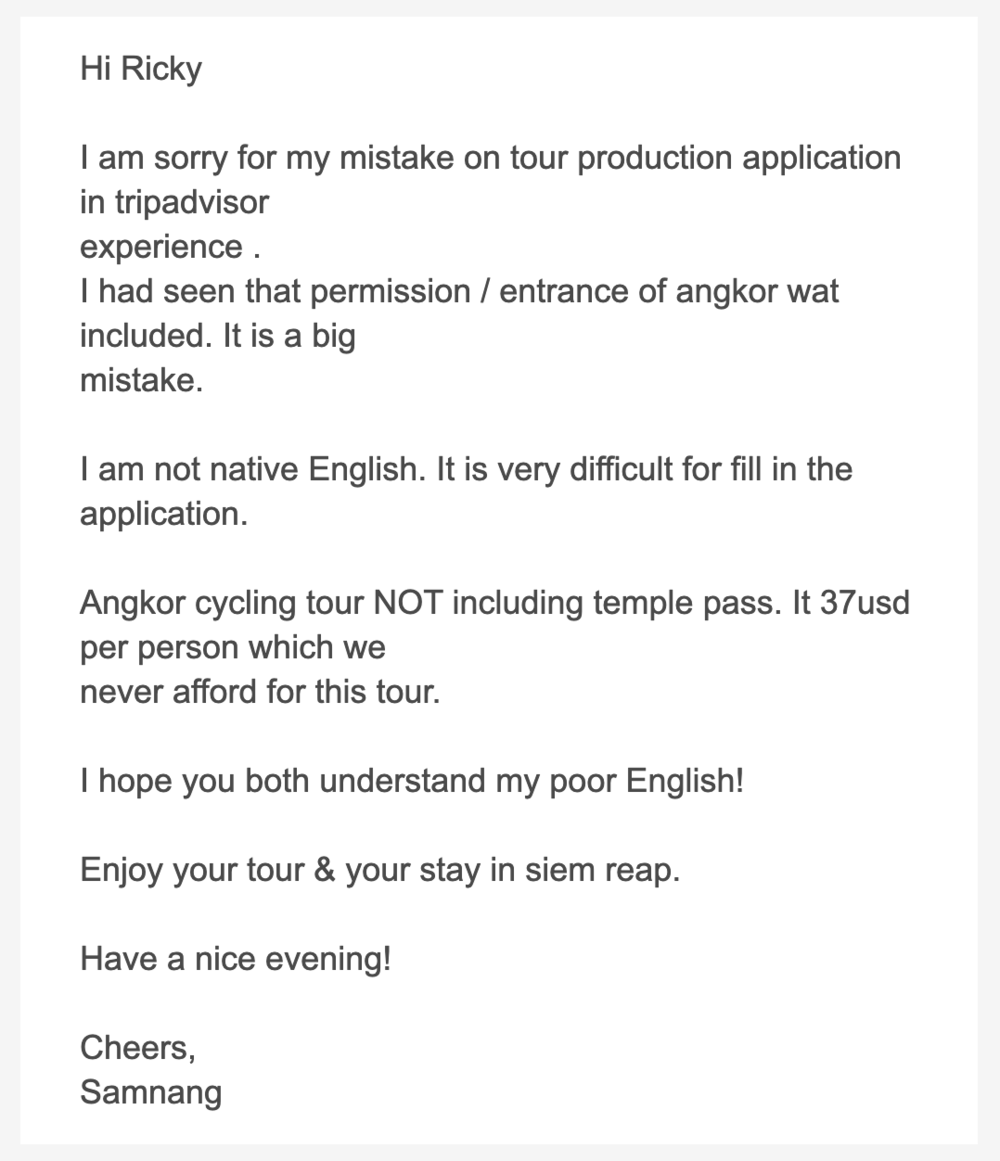
I wouldn’t put it past the tour operators, here in what I’m sure is a very competitive market, to use a little bit of “innocent” false advertising to lure in the customer – especially given the fact that the TripAdvisor page still hasn’t been corrected to remove the mention of Angkor Wat admission tickets, even though it’s been months since the operator supposedly “realized his mistake”.
Nevertheless, it was of course understandable that there’s no way a US$42 full-day cycle tour would’ve come with US$37 admission tickets included, and I knew just as much going in, so I had no qualms proceeding with the tour.
Even though we were told that we’d be met by a tuk-tuk driver who’d bring us to meet our tour guide for the day, we were in fact met at the Park Hyatt by our tour guide, Sambath, directly, who had brought all the mountain bikes and helmets with him. After kitting up and taking our bikes for a test drive around the block, we were ready to go.
Overall, the cycle tour consists of about 70% off-roading through the backroads and mountain trails of the temples complexes around Siem Reap, and about 30% cycling on the side of the city’s main roads. While Siem Reap doesn’t have any bike lanes, everyone here is pretty used to the hordes of tourists passing through on a daily basis, so we didn’t feel any element of danger when travelling along the paved roads.
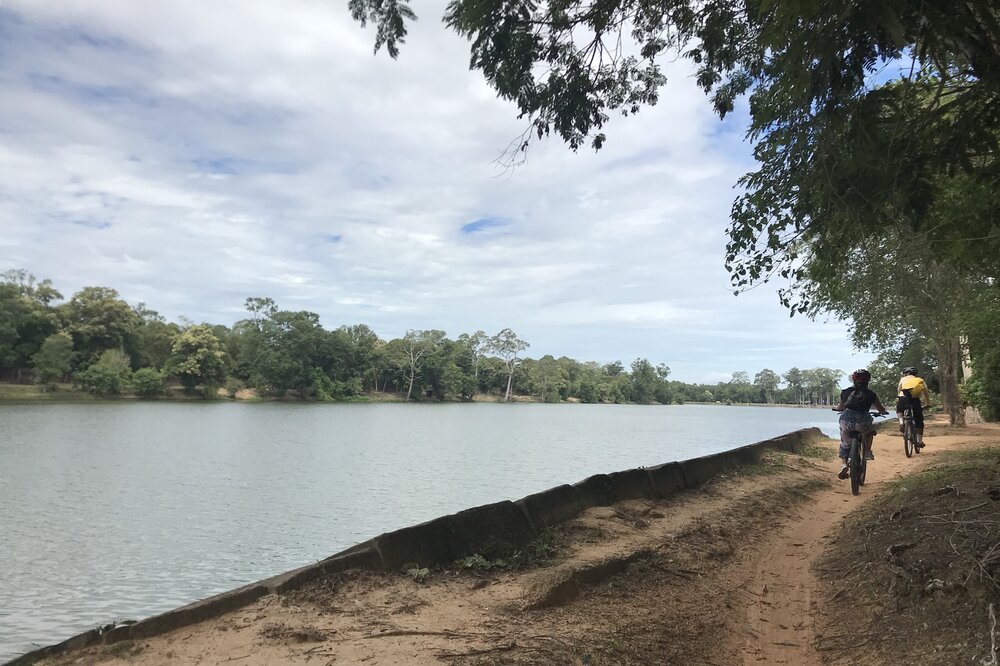
Cycling near Angkor Wat
First stop, the Angkor Wat ticket counters, which are located a few kilometres to the east of Angkor Wat itself.
Visitors to Angkor Wat may purchase a one-day, three-day, or seven-day pass, for US$37, US$62, or US$72 respectively. We’d be purchasing the one-day pass, which is either valid until 5pm on the day of purchase, or valid for the next day if purchased after 5pm.
(If you want to catch the sunrise at Angkor Wat, it’s a great idea to visit the ticket counters and purchase your ticket the day before, so that you may head to the temples bright and early.)
Meanwhile, the three- and seven-day passes do not need to be used on consecutive days, but are instead valid for a period of one week and one month, respectively.
It’s easy to get “templed out” when sightseeing in this region, so if you’re visiting Angkor for more than one day, it’d be best to break up your temple visits over multiple days and do other things in-between.
Angkor Wat
After Jessy and I purchased our park passes, we hopped back on our bikes for the cycle journey over to Angkor Wat’s eastern gates. Like before, we rode on the shoulder of the main roads for now, with the off-roading to begin later on.
The main entrance to Angkor Wat is in fact on the west side of the complex, and that’s where most of the bus-loads of tourists flood in from. Sambath was therefore very wise to bring us to the east side, where there are far fewer tourists along the trail here, making for a much more magical approach to the central towers – and you’ll still get to pass through and look at the famous views from the west side later on as well.

Angkor Wat – View from east side
[foogallery id=”16740″]
Dedicated to the Hindu god of Vishnu, Angkor Wat was built in the 12th century at the command of the ruler of the Khmer Empire at the time. Its five towers are arranged in a shape known as a quincunx, with four towers on each corner surrounding a fifth tower in the middle, themselves surrounded by three different levels of galleries, each higher than the next.
Angkor Wat’s towers struck me as surprisingly large, and the whole structure was much taller than I was expecting from looking at pictures.
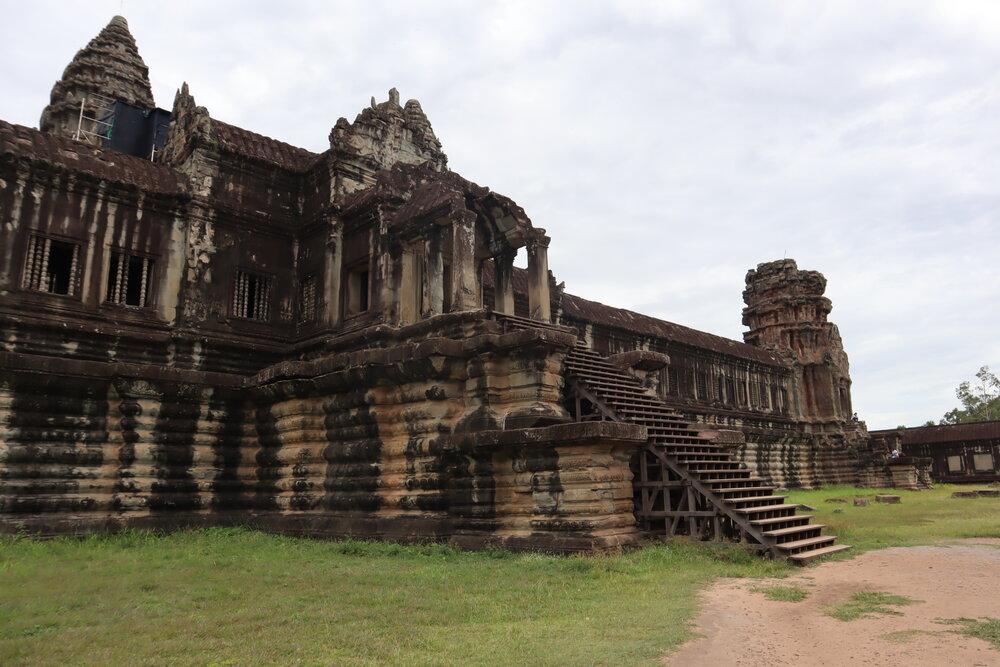
Angkor Wat – Steps to upper galleries
Sambath led us into the first gallery, showing us the reliefs along the walls depicting scenes from various Hindu epics, as well as one point along the walls where the ornate reliefs come to on end, signalling the death of the Khmer king at the time.
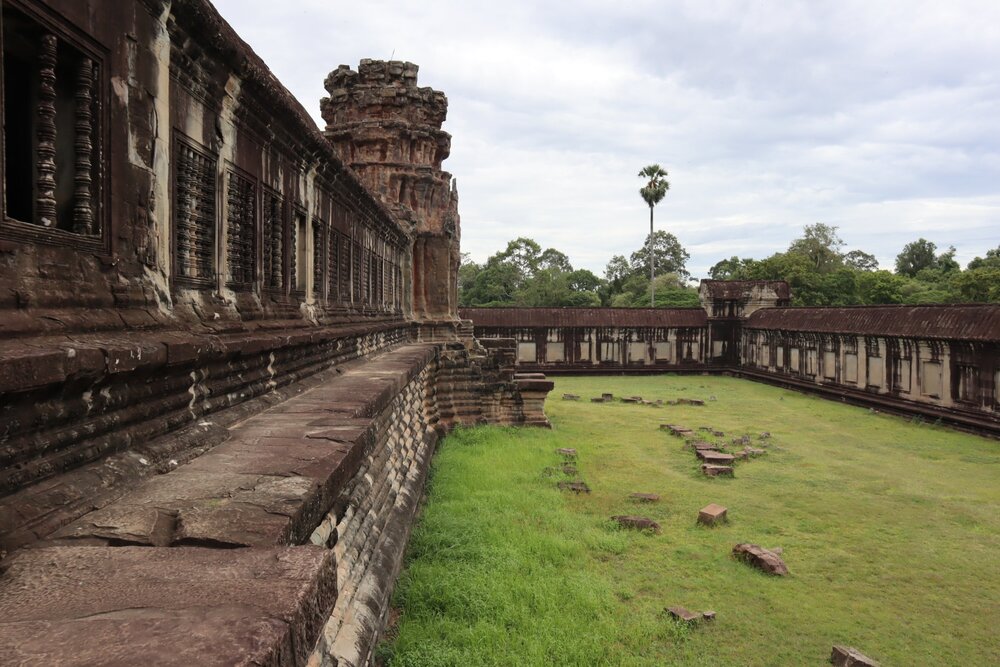
Angkor Wat – First gallery
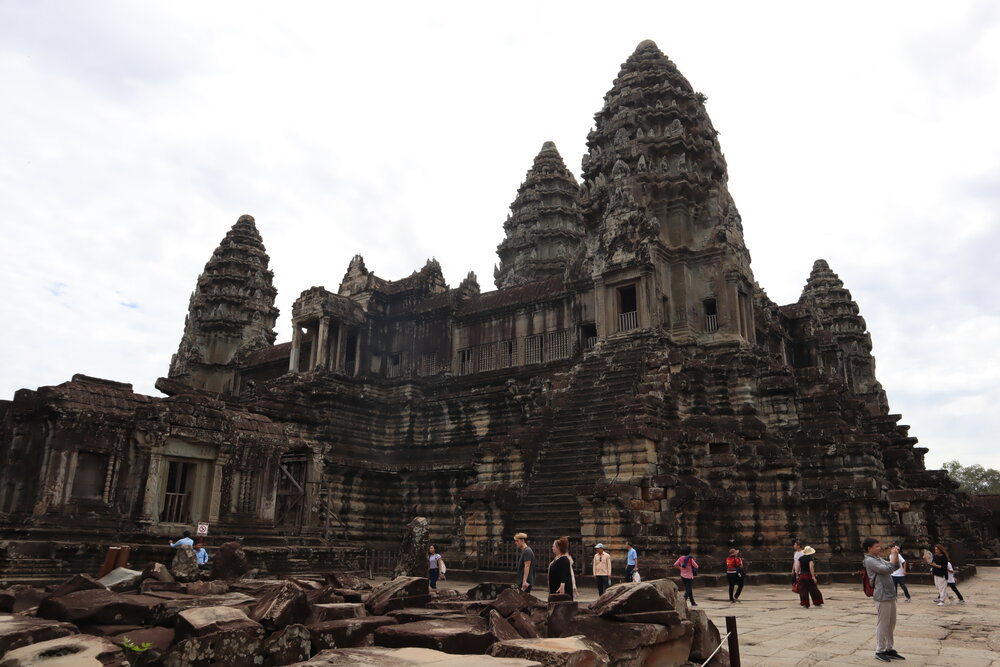
Angkor Wat – View of central towers
Our guide then hung back as we joined the ranks of tourists climbing the stairs into the second and third galleries. Despite facing extensive damage in the many centuries since its construction, Angkor Wat has been exceedingly well preserved and restored, and it’s a real pleasure to wander among its long stone corridors, admiring the Khmer architecture on display and the many devatas, or figures of the Hindu gods, carved along its walls.
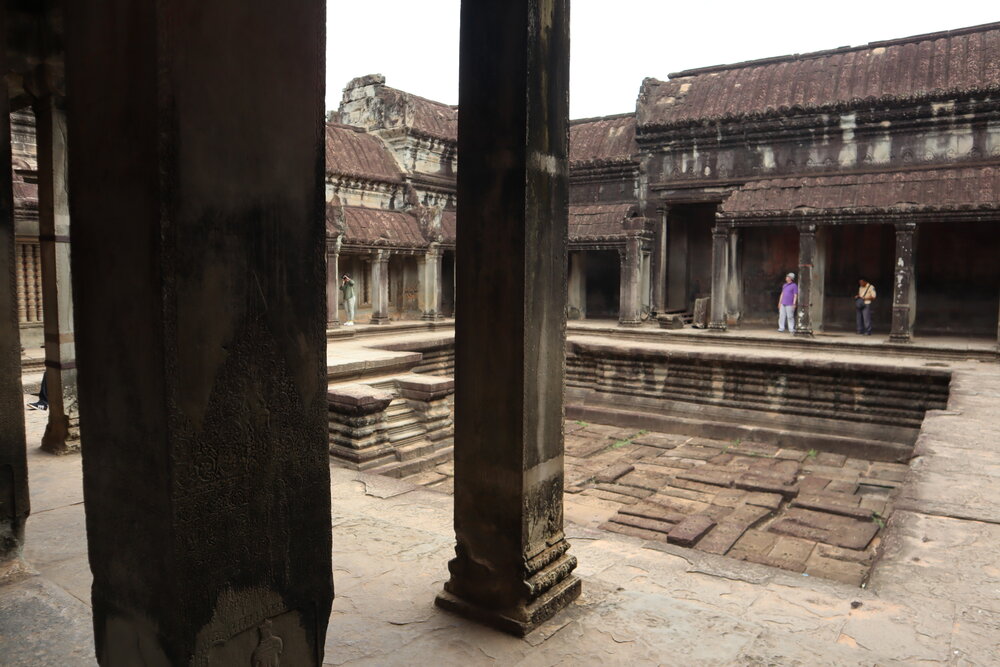
Angkor Wat – Upper gallery

Angkor Wat – Bas-reliefs

Angkor Wat – Devatas
I was briefly reminded of my visit to Nan Madol in Pohnpei – another time, another place, but the same sense of mysticism that hung in the air, at an ancient site of worship with multi-level stone galleries surrounding a central altar.
After exploring the towers, we exited Angkor Wat to the west to look at it from the front of the main complex. The imposing quincunx of towers looked truly majestic, especially when reflected in the pools of water sitting out front.
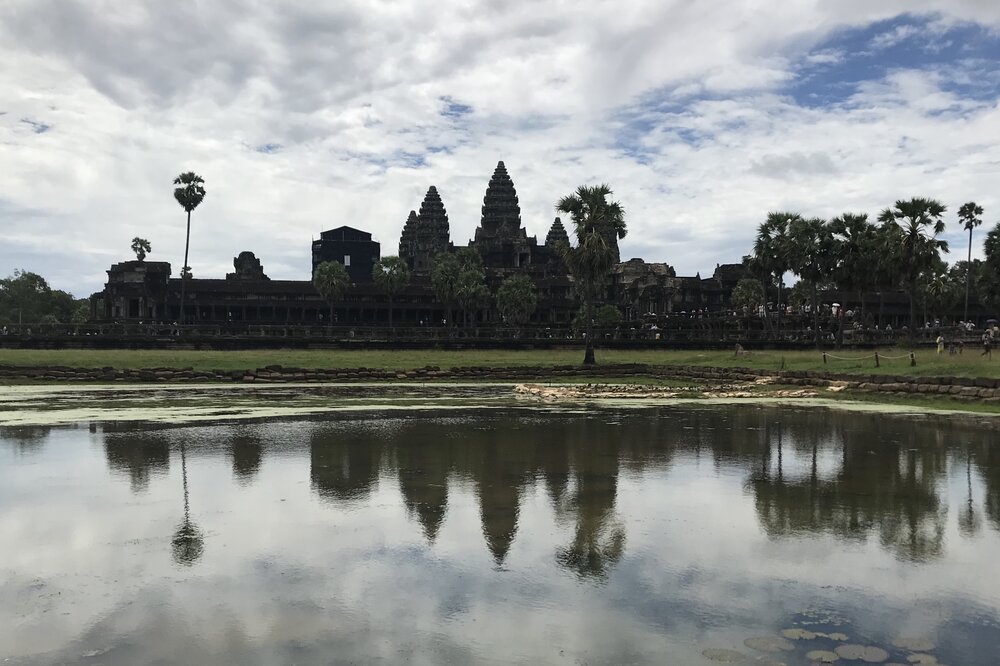
Angkor Wat – View from west side
We spent about an hour and a half at Angkor Wat in total, taking our time to admire the world’s largest religious monument from all angles. Eventually, we passed through the main temple complex again to return to the east side, where we mounted our bikes and began the off-road portion of our cycle tour bound for Angkor Thom.
The off-road cycling was mostly quite easily navigable, although there were a few stretches of tricky terrain, and I’m not ashamed to admit I fell off a few times because I wasn’t paying attention. The journey from Angkor Wat to Angkor Thom, however, was quite captivating in that we got to ride alongside the vast moat surrounding Angkor Wat, which most tourists don’t usually get to experience.
Angkor Thom / Bayon Temple
Angkor Thom technically refers to the entire ancient Khmer city sitting to the north of Angkor Wat, with the main temple at its centre known as the Bayon temple. As part of our cycle tour, we were offered the choice of heading directly to Bayon, or riding our bikes along the Angkor Thom elevated city walls, and we opted for the latter.
Shortly after we passed through the southern gates of the city walls, we took a sharp left turn and climbed the ramp up to the top of the walls themselves; it took about 15 minutes to ride all the way around to the eastern gates, where we made our way back down to ground level and headed for Bayon. I have to say, riding along the walls of Angkor Thom was yet another example of the unique perspectives we got out of exploring Angkor on two wheels rather than taking a more conventional tuk-tuk tour.
[foogallery id=”16743″]
Before checking out Bayon, we broke for lunch at one of the local restaurants, which were really just a collection of outdoor tables in the shade, each with a few Khmer dishes on the menu.
Unlike other tours we’ve been on, where the guide left us to our own devices for lunch, Sambath joined us to eat as a group, and we really enjoyed his company. It turns out he runs professional cycle tours for a living, including some gruelling endeavours of up to two weeks long across all of South East Asia, and simply does these daily cycle tours of Angkor Wat as a side hobby!
We visited Bayon after a reenergizing lunch of fish amok and chicken curry. The style of this temple is much more rough around the edges when compared to Angkor Wat, and is particularly noteworthy for the many smiling faces carved into the stone walls, which are said to resemble the face of the King Jayarvaman VII, one of the most prominent Khmer kings for whom Bayon acted as the dedicated state temple.

Bayon Temple, Angkor Thom
[foogallery id=”16746″]
There are actually about a dozen smaller temples here in the Angkor Thom complex, but I felt that visiting all of them would probably have made us “templed out” quite easily. If you had a longer time in the region, then it could be worthwhile to spend a whole day exploring Angkor Thom and saving your visits to other temples for another day on your Angkor Pass.
Ta Nei
Instead, we headed to Ta Phrom temple via a small detour through Ta Nei, a smaller “hidden” temple deep in the jungles that we reached via the longest stretch of off-road cycling on the tour thus far (not that it was anything too treacherous in the end).
Ta Nei is constructed in the same Baroque style as Bayon, and its isolated setting in the lush tropical jungle made it one of my favourite stops along the entire tour, especially since there were very few other tourists around.
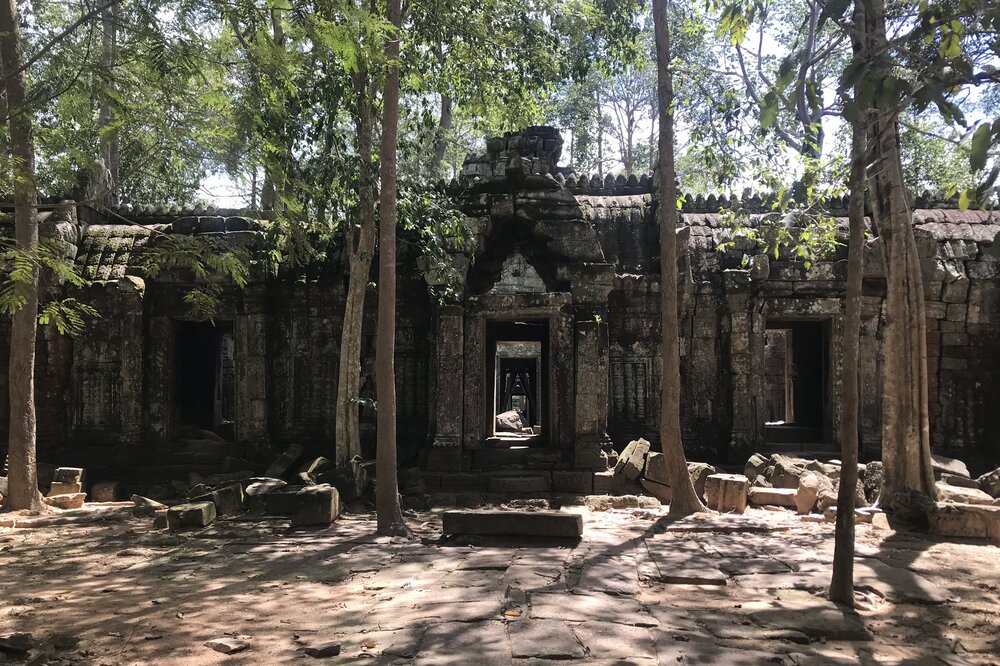
Ta Nei
Compared to Angkor Wat, Ta Nei is also a relatively dilapidated place, with some parts of the temple slowly falling into disrepair and others having never been finished in the first place, which only added to the mystical atmosphere as it caught the few rays of sunlight that shone through the dense foliage.
Ta Phrom
Finally, we headed to Ta Phrom, one of Angkor’s most popular temples which is known for its huge, almost alien-like tree trunks sprouting out of the ruins and forming a part of the temple itself.

Ta Phrom
Like Angkor Wat, Ta Phrom also consists of three galleries surrounding a central sanctuary, but like Bayon and Ta Nei, the site is partially collapsed, so your path as a visitor is rather roundabout as you traverse the corridors, duck under doorways, and step over the majestic trees’ roots snaking all across the ground.
[foogallery id=”16751″]
Jessy and I were downright exhausted from cycling through the harsh summer heat by this point, so we were content to simply sit down and admire Ta Phrom’s beauty in peace, without moving around too much.
Indeed, while we had the option to conclude the tour with one final ride back to the hotel, we both felt too tired to continue, so Sambath phoned up one of his tuk-tuk driver friends, and we strapped our three mountain bikes to the frame of the vehicle with some simple South East Asian ingenuity before enjoying a breezy ride to the hotel to finish off our tour.
Conclusion
Our cycle tour of Angkor Wat proved to be one of the most rewarding travel days we’ve had in many years. Not only did we get to spend meaningful amounts of time at some of the most significant temple sites in the region, including the awe-inspiring Angkor Wat, but we also got some great exercise in doing so while also being treated to some unique perspectives of the temples that you wouldn’t get with an ordinary tuk-tuk driver.
While we had originally booked via Camouflage Adventures Cambodia, our guide Sambath actually runs his own tour agency, Away Adventure Tours, as well, and we’d recommend his services very highly if you’re looking to explore Angkor Wat in an active fashion and treat yourself to a very memorable day out in the temples.




















This bicycle tour looks awesome, definitely something I will keep in mind when I visit.
How are you getting around to the different cities in Southeast Asia?
Mostly low-cost carriers – especially in Cambodia, there are a whole bunch of new startup airlines offering low-cost flights. I flew with Lanmei Airlines from PP to Siem Reap, followed by a VietJet Air flight to Hanoi, where I caught my Cathay First flight to Vancouver finish this trip.
This is probably my top travel destination presently!